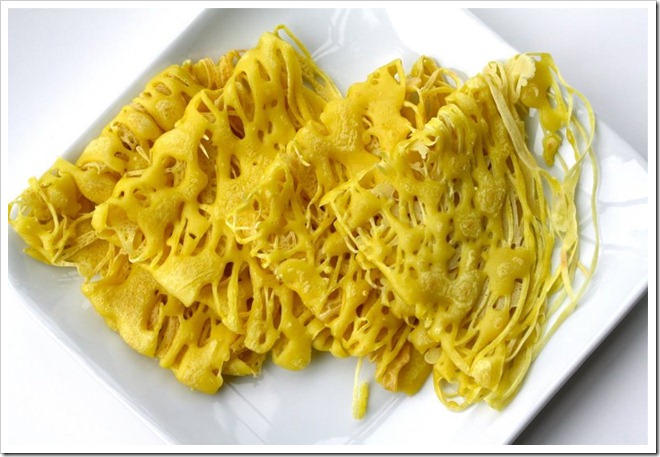
This is a traditional Malay dish and literally translated, Roti Jala means something totally different! “Roti” is bread, while “jala” is fishing net! But the description is apt. When it is first made, it does looks like a fishing net. But I think “Lacey Crepes” is a more elegant and worthy name for this dish because in fact it is more a crepe than it is a bread and it is more lacey than fishing net 

Once cooked each crepe is folded into four like in the photograph above, or sometimes, it is rolled, like the photograph below.

It is called “roti” in Malay I guess because it is never eaten alone. Like bread, it is always eaten with something, either a sweet dish or for us usually, a curry. When I serve Roti Jala, its always with my chicken curry!
I recipised the dish because I just had to try and make it. Its fine in Malaysia – if you don’t know how to make it, you can order it, or you will find it in a Malay stall at a night market. During the month of Ramadhan, roti jala can be found at almost every Bazaar Ramadhan.
When we lived in Dubai of course, if you can’t make it you don’t get to eat it! So when Mum and my late Dad came to visit us in Dubai, I watched her make it and forced her to measure everything. And this is her recipe.
INGREDIENTS
3 cups flour
3 1/3 cups water
1 egg (or 2 for a richer taste)
Salt to taste
Yellow food colouring
Vegetable oil for the pan
Kitchen paper for applying the oil to the pan
Pandanus leaves for patting the crepes with oil
DIRECTIONS
Mix all the ingredients in a mixing bowl using a hand blended. Make sure there are no lumps. Pour the mixture through a sieve to remove any little lumps.
Shred a couple of pandanus leaves lengthwise, fold into to and tie the end with a rubber band or twine to hold it together.
Heat a heavy-based pan and using a piece of kitchen paper, dab in a bit of oil and rub the pan with it. When it starts to smoke a little the pan is ready.
Make one crepe at a time. Pour a little of the mixture into the roti jala tool sitting on a plate, bring it to the pan and swirl in small circular motions making sure they overlap to create the lacey effect. If the mixture does not make a “smooth” lace but instead comes out in drips and drops, the mixture is too thick. Add a bit of water, mix well and try again.
When the surface gets shiny, it is almost ready. Dip the pandanus leaf into some oil and pat the crepe with it. Lift the crepe off the pan onto a plate and fold it or roll it. Refill the tool and make the next crepe.









